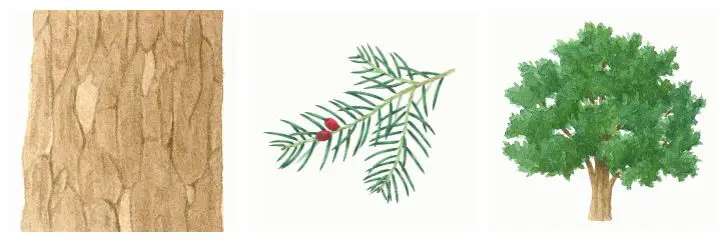Yew
Yew

One of the oldest living trees in northern Europe, the yew - or Taxus baccata - is one of the three conifers native to Britain (the others are Scots pine and juniper). They bear succulent red fruits instead of cones.
These huge and ancient trees are common in churchyards, and some are thought to be thousands of years old.
Facts and stats
- Uses: Although a ‘softwood’ it grows slowly, giving the wood great strength. Its thin, springy branches were once used for making longbows. Nowadays the wood is made into veneers and is used for furniture making. Yew is popular in gardens as it can withstand unlimited clipping and shaping.
- Seeds: Every part of the tree - except the fleshy seed cap - is poisonous to humans and cattle but not to deer or rabbits. When a bird eats one of the fruits it digests the fleshy jacket, or aril, and passes the poisonous seed intact.
- Flower: Male and female flowers are borne on separate trees, which is a primitive feature in conifers.
- Bark: The light brown bark is thin and scaly, becoming deeply furrowed and breaks away in long flakes.
- Height: Usually a round densely- branched tree from 15 to 29 metres tall.
- Lifespan: 5, 000 years
- Supporting insect species: 6
- Natural range: Europe, Atlas Mountains, Asia Minor to Persia
Famous yew trees in Scotland
Fortingall Yew
At the fine old age of around 5,000 years, the Fortingall Yew is certainly one of the oldest trees in the United Kingdom, if not in Europe. This venerable specimen lives in a churchyard, west of Aberfeldy. It's believed centuries ago, locals cut large sections off the tree to create quaichs - or drinking cups - and has been used as an arch for funeral processions to pass through.
Stevenson's Yew
This living link to one of Scotland's literary greats, Robert Louis Stevenson, stands in the private grounds of a house in Colinton, Edinburgh. The Treasure Island author is known to have played in the branches of this ancient yew, when he spent some of his childhood living in the house with his grandfather.
The Whittingehame Yew
This storied specimen is a magnificent sight to behold. It's vast ring of outer growth covers a large area of ground, creating a canopy of branches and shady inner sanctum. Legend has it the demise of Mary Queen of Scots' second husband was plotted beneath these very branches. The tree sits in private grounds in the East Lothian estate of Whittingehame.